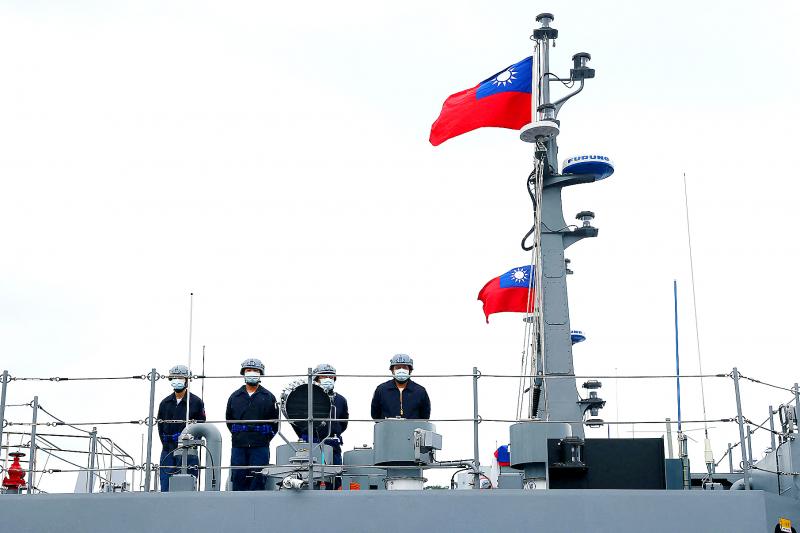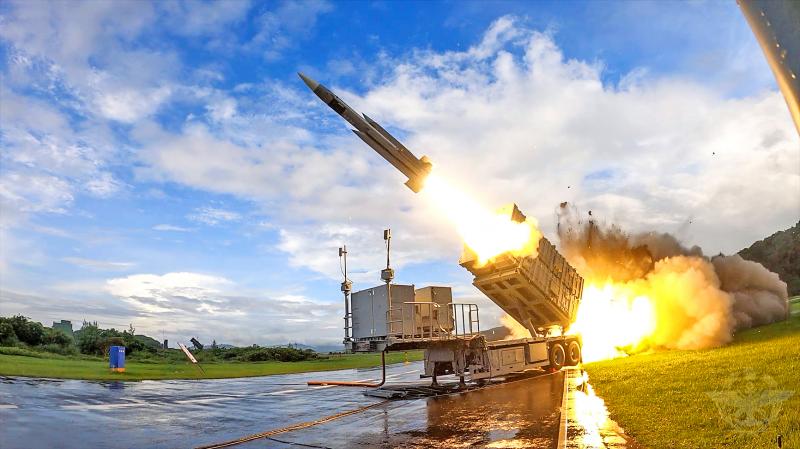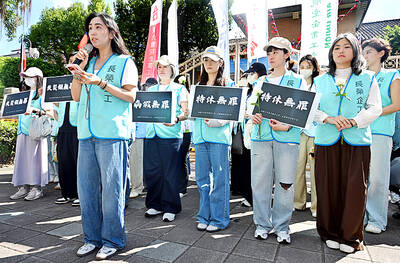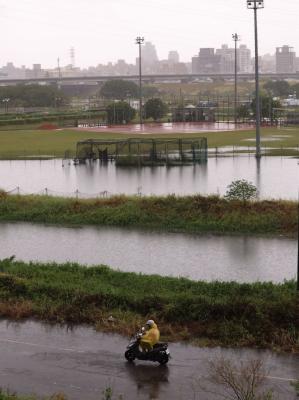On Taiwan’s tiny Penghu islands, the missile bases that sit next to white-sand beaches and bustling fish markets are a visceral reminder of the constant threat of attack from China.
Despite the huge military discrepancy between the two sides, many analysts believe that Taiwan’s location, inhospitable terrain and US support would make a full-scale invasion extremely difficult for China — and possibly too costly to countenance.
Recent record incursions of Chinese fighter jets into Taiwan’s air defense identification zone and increasingly aggressive rhetoric from the administration of Chinese President Xi Jinping (習近平) have raised fears that China might contemplate acting on a pledge to “reunify” Taiwan sooner rather than later.

Photo: Ann Wang/Reuters
The Chinese Ministry of National Defense last week said it would “not hesitate to start a war” to “stop Taiwan from becoming independent.”
One US admiral said an attack could come by 2027, the centenary of China’s People’s Liberation Army (PLA).
“If we were to go head to head militarily, we don’t stand a single chance,” said retired admiral Lee Hsi-min (李喜明), who was head of Taiwan’s armed forces until 2019.

Photo: EPA-EFE
However, Russia’s failure to quickly overrun Ukraine stands as a cautionary tale for Beijing, while simultaneously providing Taipei with tactical blueprints and inspiration on how to hold off a much larger enemy.
“Our soldiers here are all Taiwanese and will be fighting to defend their homeland,” said Chen Ing-jin, a Penghu historian and architect. “That makes a difference. Just look at Ukraine.”
Taiwan’s biggest advantage is its geography.
Amphibious assaults are exceedingly difficult, and if China were to invade Taiwan — and, crucially, hold it — Beijing would need to move hundreds of thousands of troops, along with equipment, across the Taiwan Strait.
Even at its narrowest point, the strait is 130km and weather conditions are notoriously unforgiving, especially during two monsoon seasons. That leaves just two brief “windows of attack” — May to July and October — for such a large-scale operation, a US Naval War College report said.
In addition, studded into the waters are outlying islands like the Penghu chain — bristling with radar and missiles pointing out into the strait. With the likely early warning and the weaponry Taipei has at its disposal, the PLA would probably incur high losses in that first stage of transit, said James Char, associate research fellow at Singapore’s S. Rajaratnam School of International Studies.
While the small, flat outlying islands might in the end prove easy for Beijing to subdue, on Taiwan’s main island, the opposite applies.
The coastal terrain “is a defender’s dream come true,” said Ian Easton, author of The Chinese Invasion Threat.
He and his colleagues estimate that Taiwan only has 14 small beaches suitable for landing, and they are bordered by mountains, cliffs or dense urban infrastructure.
“Landing on Taiwan is only part of the problem,” said Bonny Lin (林洋), director of the China Power Project at the Center for Strategic and International Studies.
Progress through Taiwan’s wetlands, mountains and densely populated urban areas would require a huge range of combat skills and weapons.
“How is it going to sustain those forces once they’re in position and advancing?” Lin asked. “How is it going to do the logistics?”
China has spent the equivalent of hundreds of billions of US dollars upgrading its military capabilities over the past decade, and its statistical dominance over Taiwan is enormous.
The PLA has more than 1 million ground force personnel to Taiwan’s 88,000; 6,300 tanks compared with 800; and 1,600 fighter jets to 400, US Department of Defense data show.
Washington also estimates that Beijing has the world’s largest navy by ship number. A recent US Naval War College paper described those ships as “increasingly sophisticated, capable vessels.”
However, many experts, including Char and Lin, question whether they are yet capable enough.
Atlantic Council senior adviser Harlan Ullman put it more forcefully in a February paper: “China simply lacks the military capability and capacity to launch a full-scale amphibious invasion of Taiwan for the foreseeable future.”
In the meantime, Taiwan has plans to counter China’s might in numbers, with Lee highlighting asymmetric warfare — an emphasis on mobility and precision attacks — an approach US officials are reportedly encouraging. Lee pointed to the success of the Ukrainian mobile missile launcher that sank Russia’s Black Sea flagship, the Moskva.
Taiwan has built up stockpiles of mobile missile batteries and shoulder-launched weapons, but he said they need substantially more.
The factor that preoccupies Beijing most is who else might get involved in the conflict, Chinese military expert Song Zhongping (宋忠平) said.
“The difficulty of liberating Taiwan lies in the potential intervention of the United States. It’s the biggest obstacle for the PLA to clear,” he said.
The US officially maintains a policy of “strategic ambiguity” on whether it would intervene militarily in the event of an invasion. Regardless, it supplies Taiwan with military hardware, while US President Joe Biden has said multiple times that Washington would intervene.
The “extent, depth and breadth” of US and other allies’ involvement would greatly determine how any conflict would play out, Song said.
Even without a military intervention, Char said the threat of economic sanctions, such as those placed on Russia, would give Chinese leadership pause for thought.
Whether China would be prepared to cause mass casualties with an invasion, while risking its domestic and international image, is a fundamental question.
“You need to let China know that it will suffer tremendous losses, and even then it may still not be able to occupy Taiwan,” Lee said. “So that China will think that the best way to resolve the Taiwan problem is by peaceful means.”

The Taoyuan Flight Attendants’ Union yesterday vowed to protest at the EVA Air Marathon on Sunday next week should EVA Airway Corp’s management continue to ignore the union’s petition to change rules on employees’ leave of absence system, after a flight attendant reportedly died after working on a long-haul flight while ill. The case has generated public discussion over whether taking personal or sick leave should affect a worker’s performance review. Several union members yesterday protested at the Legislative Yuan, holding white flowers and placards, while shouting: “Life is priceless; requesting leave is not a crime.” “The union is scheduled to meet with

‘UNITED FRONT’ RHETORIC: China’s TAO also plans to hold weekly, instead of biweekly, news conferences because it wants to control the cross-strait discourse, an expert said China’s plan to expand its single-entry visa-on-arrival service to Taiwanese would be of limited interest to Taiwanese and is a feeble attempt by Chinese administrators to demonstrate that they are doing something, the Mainland Affairs Council said yesterday. China’s Taiwan Affairs Office (TAO) spokesman Chen Binhua (陳斌華) said the program aims to facilitate travel to China for Taiwanese compatriots, regardless of whether they are arriving via direct flights or are entering mainland China through Hong Kong, Macau or other countries, and they would be able to apply for a single-entry visa-on-arrival at all eligible entry points in China. The policy aims

Taipei, New Taipei City, Keelung and Taoyuan would issue a decision at 8pm on whether to cancel work and school tomorrow due to forecasted heavy rain, Keelung Mayor Hsieh Kuo-liang (謝國樑) said today. Hsieh told reporters that absent some pressing reason, the four northern cities would announce the decision jointly at 8pm. Keelung is expected to receive between 300mm and 490mm of rain in the period from 2pm today through 2pm tomorrow, Central Weather Administration data showed. Keelung City Government regulations stipulate that school and work can be canceled if rain totals in mountainous or low-elevation areas are forecast to exceed 350mm in

EVA Airways president Sun Chia-ming (孫嘉明) and other senior executives yesterday bowed in apology over the death of a flight attendant, saying the company has begun improving its health-reporting, review and work coordination mechanisms. “We promise to handle this matter with the utmost responsibility to ensure safer and healthier working conditions for all EVA Air employees,” Sun said. The flight attendant, a woman surnamed Sun (孫), died on Friday last week of undisclosed causes shortly after returning from a work assignment in Milan, Italy, the airline said. Chinese-language media reported that the woman fell ill working on a Taipei-to-Milan flight on Sept. 22